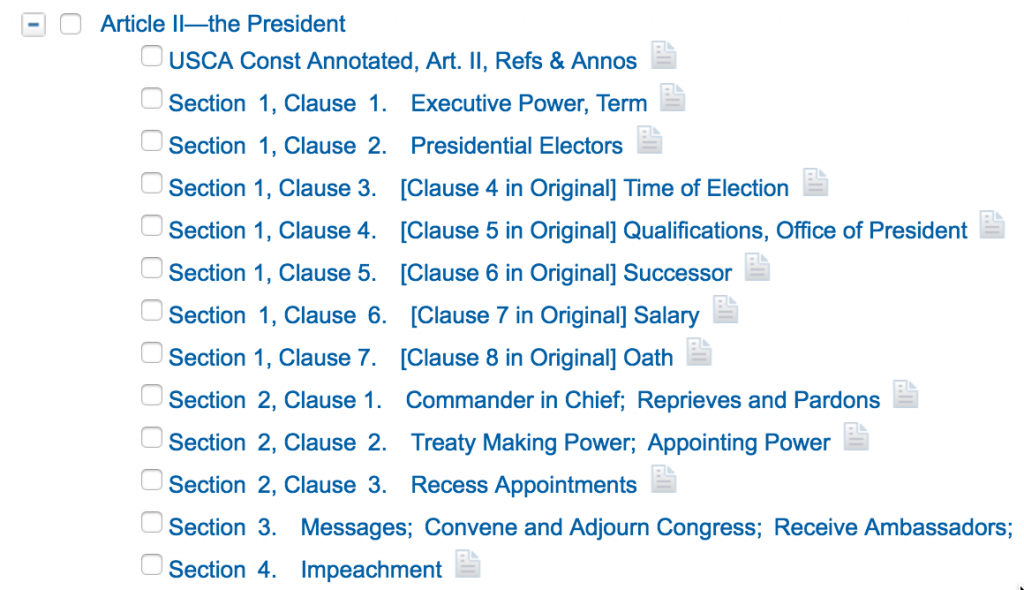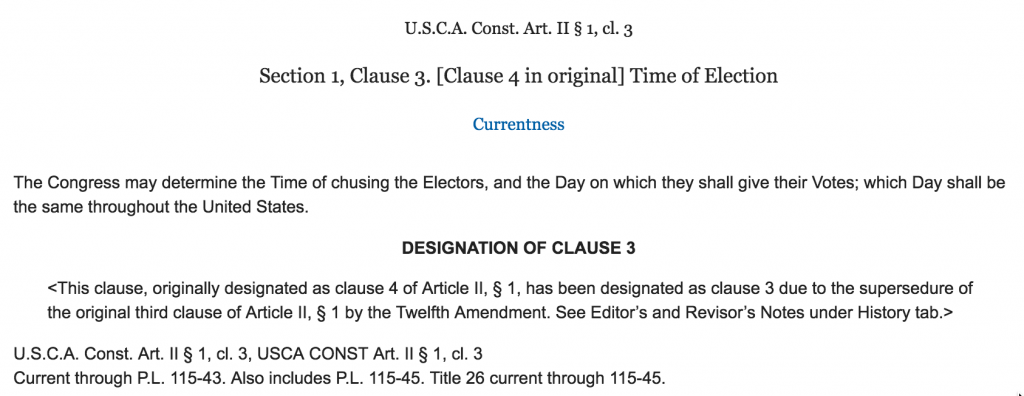In the earliest days of our Republic, a debate ensued about how the amendments would be incorporated into the Constitution. James Madison called for “interweaving” the new provisions into the original text of the Constitution of 1787, rather than appending them at the end. This proposal was defeated following debate in the House. Two centuries later, WestLaw still adheres to Madison’s view, at least in Article II, Section 1. This news comes from Christopher G. Wren, an Assistant Attorney General in the Wisconsin Department of Justice, Criminal Appeals Unit, via the Scribes newsletter.
Article II, Section 1, Clause 3 provides:
The Electors shall meet in their respective States, and vote by Ballot for two Persons, of whom one at least shall not be an Inhabitant of the same State with themselves. And they shall make a List of all the Persons voted for, and of the Number of Votes for each; which List they shall sign and certify, and transmit sealed to the Seat of the Government of the United States, directed to the President of the Senate. The President of the Senate shall, in the Presence of the Senate and House of Representatives, open all the Certificates, and the Votes shall then be counted. The Person having the greatest Number of Votes shall be the President, if such Number be a Majority of the whole Number of Electors appointed; and if there be more than one who have such Majority, and have an equal Number of Votes, then the House of Representatives shall immediately chuse by Ballot one of them for President; and if no Person have a Majority, then from the five highest on the List the said House shall in like Manner chuse the President. But in chusing the President, the Votes shall be taken by States, the Representation from each State having one Vote; A quorum for this Purpose shall consist of a Member or Members from two thirds of the States, and a Majority of all the States shall be necessary to a Choice. In every Case, after the Choice of the President, the Person having the greatest Number of Votes of the Electors shall be the Vice President. But if there should remain two or more who have equal Votes, the Senate shall chuse from them by Ballot the Vice President.
If you click on this provision, the Archives takes you to the page that lists the 12th Amendment with this note:
Note: A portion of Article II, section 1 of the Constitution was superseded by the 12th amendment.
Students of the Constitution will know that the 12th Amendment was designed to remedy the flawed method of selecting a President under the Constitution of 1787.
WestLaw, however, handled this amendment differently: it simply eliminated Clause 3 from Article II, Section 1, and renumbered the remaning clauses in Article II, Section 1.

For example, the Time of Election Clause, which appears fourth in the National Archives, appears third on WestLaw. At the bottom of the page, there is a note that explains the renumbering is “due to the supersedure of the original third clause of Article II, § 1 by the Twelfth Amendment.”

The “Editor’s and Revisor’s Notes under History tab” explains that “A former clause 3, which was superseded, read as follows,” followed by the text of the original third clause. This is the only way to find on Westlaw the text that was superseded by the Twelfth Amendment.
This perplexing editorial decision could be justified if it was consistent, but it is not. All other provisions of the Constitution that were superseded or modified by subsequent amendment are still in place, and not renumbered.
The National Archives lists all of the relevant changes:
- Article III, section 2, of the Constitution was modified by amendment 11.
- A portion of Article II, section 1 of the Constitution was superseded by the 12th amendment.
- A portion of Article IV, section 2, of the Constitution was superseded by the 13th amendment.
- Article I, section 2, of the Constitution was modified by section 2 of the 14th amendment.
- Article I, section 9, of the Constitution was modified by amendment 16.
- Article I, section 3, of the Constitution was modified by the 17th amendment.
- Under the 18th Amendment is this notation: “Repealed by amendment 21.”
- Article I, section 4, of the Constitution was modified by section 2 of this amendment [20th]. In addition, a portion of the 12th amendment was superseded by section 3.
- Article II, section 1, of the Constitution was affected by the 25th amendment.
- Amendment 14, section 2, of the Constitution was modified by section 1 of the 26th amendment.
According to the Scribes newsletter, a Westlaw reference attorney said “there didn’t seem to be any consistent rationale” to this decision.